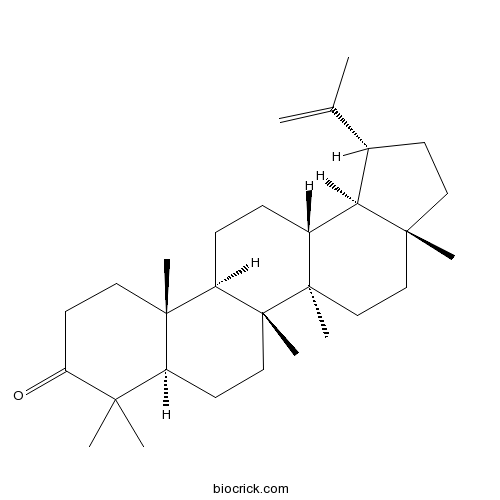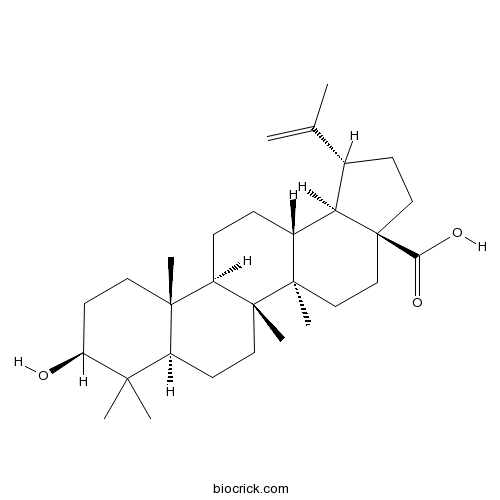Betula platyphylla
Betula platyphylla
1. The products in our compound library are selected from thousands of unique natural products; 2. It has the characteristics of diverse structure, diverse sources and wide coverage of activities; 3. Provide information on the activity of products from major journals, patents and research reports around the world, providing theoretical direction and research basis for further research and screening; 4. Free combination according to the type, source, target and disease of natural product; 5. The compound powder is placed in a covered tube and then discharged into a 10 x 10 cryostat; 6. Transport in ice pack or dry ice pack. Please store it at -20 °C as soon as possible after receiving the product, and use it as soon as possible after opening.
Natural products/compounds from Betula platyphylla
- Cat.No. Product Name CAS Number COA
-
BCN1717
Lupenone1617-70-5
Instructions

-
BCN5524
Betulinic acid472-15-1
Instructions

-
BCN5528
Betulin473-98-3
Instructions

-
BCN5725
Lupeol545-47-1
Instructions

Bioactivity evaluations of betulin identified from the bark of Betula platyphylla var. japonica for cancer therapy.[Pubmed: 30109574]
None
Molecular cloning and functional analysis of a UV-B photoreceptor gene, BpUVR8 (UV Resistance Locus 8), from birch and its role in ABA response.[Pubmed: 30080616]
As a photoreceptor specifically for UV-B light, UVR8 gene plays an important role in the photomorphogenesis and developmental growth of plants. In this research, we isolated the UVR8 gene from birch, named BpUVR8 (AHY02156). BpUVR8 overexpression rescued the uvr8 mutant phenotype using functional complementation assay of BpUVR8 in Arabidopsis uvr8 mutants, which showed that the function of UVR8 is conserved between Arabidopsis and birch. The expression analysis of BpUVR8 indicated that this gene is expressed in various tissues, but its expression levels in leaves are higher than in other organs. Moreover, abiotic stress factors, such as UV-B, salinity, and abscisic acid (ABA) can induce the expression of BpUVR8 gene. Interestingly, the analysis of promoter activity indicated that BpUVR8 promoter not only has the promoting activity but can also respond to the induction of abiotic stress and ABA signal. So, we analyzed its function in ABA response via transgenic UVR8 overexpression in Arabidopsis. The BpUVR8 enhances the susceptibility to ABA, which indicates that BpUVR8 is regulated by ABA and can inhibit seed germination. The root length of 20-day-old 35S::BpUVR8/WT transgenic plants was 18% reduced as compared to the wild-type under the ABA treatment. The membrane of the BpUVR8-overexpressing in Arabidopsis thaliana was the most damaged after ABA treatment and 35S::BpUVR8/WT transgenic plant was more sensitive to ABA than the wild type. These results showed that BpUVR8 is a positive regulator in the ABA signal transduction pathway. In the presence of low dose of UV-B, the sensitivity of wild-type and 35S::BpUVR8/WT plants to ABA was reduced. Moreover, BpUVR8 regulates the expression of a subset of ABA-responsive genes, both in Arabidopsis and Betula platyphylla, under the ABA treatment. Our data provide evidence that BpUVR8 is a positive regulator in the UV-B-induced photomorphogenesis in plants. Moreover, we propose from this research that BpUVR8 might have an important role in integrating plant growth and ABA signaling pathway.
Identification of novel cis-elements bound by BplMYB46 involved in abiotic stress responses and secondary wall deposition.[Pubmed: 29877625]
Transcription factors (TFs) play vital roles in various biological processes by binding to cis-acting elements to control expressions of their target genes. The MYB TF BplMYB46, from Betula platyphylla, is involved in abiotic stress responses and secondary wall deposition. In the present study, we used a TF-centered yeast one-hybrid technology (TF-centered Y1H) to identify the cis-acting elements bound by BplMYB46. We screened a short-insert random library and identified three cis-elements bound by BplMYB46: an E-box (CA(A/T/C)(A/G/C)TG) and two novel motifs, a TC-box (T(G/A)TCG(C/G)) and a GT-box (A(G/T)T(A/C)GT(T/G)C). Chromatin immunoprecipitation (ChIP) and effector-reporter coexpression assays in Nicotiana tabacum confirmed binding of BplMYB46 to the TC-box, GT-box, and E-box motifs in the promoters of the phenylalanine ammonia lyase (PAL), peroxidase (POD), and superoxide dismutase (SOD) genes, which function in abiotic stress tolerance and secondary wall biosynthesis. This finding improves our understanding of potential regulatory mechanisms in the response to abiotic stress and secondary wall deposition of BplMYB46 in B. platyphylla.
[Individual tree diameter increment model for natural Betula platyphylla forests based on meteorological factors].[Pubmed: 29745147]
None
[Spatial variation in diurnal courses of stem temperature of Betula platyphylla and Fraxinus mandshurica and its influencing factors].[Pubmed: 29692137]
None


